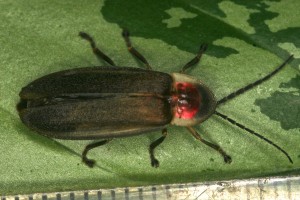- Newly discovered day flashing firefly from the Panamanian rainforest. Why flash in the day?
Video at: https://www.facebook.com/fredric.vencl/videos/g.618366604953262/10203920259829335/?type=2&theater
Featured article: http://biotropica.org/editors-choice-biotropica-485/
- Do fireflies have visual or chemical warning signals that constitute an aposematic defense? Although famous for photic courtship displays, fireflies (Coleoptera: Lampyridae) are also notable for emitting strong odors when molested. Many fireflies are endowed with noxious chemicals that make them unpalatable prey. The identity of volatile emissions and their possible role, along with photic signals, as aposematic warnings of unpalatability have been little explored, especially in tropical species. Pursuant to the observation that the widespread Neotropical fireflies, Photuris trivittata and Bicellonycha amoena, emit pungent odors, glows, and flashes when handled, we investigated their cuticular and headspace chemistry. Gas chromatography–mass spectrometry (GC-MS) analyses revealed that both fireflies have species-specific cuticular hydrocarbon profiles. Photuris trivittata headspace was dominated by 2-methoxy-3-(1-methylpropyl) pyrazine (hereafter, pyrazine), on the order of 1.59 ng/individual and a suite of sesquiterpenes, while B. amoena emitted 3-methoxy-2-butenoic acid methyl ester and a few ketones. This is the first report of such compounds in fireflies. We investigated the role of pyrazine in P. trivittata’s interactions with potential predators: sympatric ants, toads, and bats. Solvent-washed P. trivittata painted with pyrazine incurred lower ant predation than did their solvent-washed counterparts. Pyrazine significantly repelled ants at baits in concentrations as low as 9.8×10-4 ng/μl. The toad, Rhinella marina, readily accepted intact fireflies, pyrazine-coated and uncoated mealworms. Both Myotis nigricans and Molossus molossus bats rejected fireflies, but accepted both pyrazine-coated and un-coated mealworms. While pyrazine repels ants, its role as an aposematic signal warning other potential predators of firefly distastefulness requires further investigation. Our results underscore the idea that multiple enemies exert conflicting selection on firefly defenses. Biotropica (2016) 48 (5): 654-656.
- Sexual selection in fireflies: Do exaggerated morphological, behavioral, or photic display characteristics confer greater reproductive success?
Male competition in courtships of the firefly is intense. Morphometric analysis revealed that male size is variable, possibly exhibiting alternative body plans. We examined the outcomes of courtships to determine the proximate mechanisms of selection that may have led to male allometry. Two distinct selective events exist within mate competition: (I) searching and (2) scramble competition. Although many courtships failed, those without rivals were shorter and successful males spent less time in the “mate-guarding” position than when several males were in competition. Winners outflashed rivals, but flash dialogs occurred at similar frequencies across rival densities, indicating that females require some quantum of information before mating. Female flash preference was examined in choice tests to evaluate female discrimination ability. Females preferred flashes of greater intensity and precedence. This suggests that flash ” synchronization” is a competitive display rather than a cooperative behavior to maintain female responsiveness. Selection for male size was density dependent: females preferred large males in searching, while small males werefavored in scrambles. Simulated scrambles showed that small males have superior locomotor abilities, allowing them to reach the female rapidly. Comparison with a species lacking scrambles, P. macdermotti, revealed that selection in P. pyralis is disruptive, targeting traits alternately, and may have led to the evolution of higher allometric ratios in a species with direct male competition. Both male competition and female choice are important determinants of the outcome of P. pyralis courtships. (2004) Allometry and proximate mechanisms of sexual selection in Photinus fireflies and some other beetles. Integr. Comp. Biol. (2004) 44: 242-249.
Do novel defensive traits foster escape from predators and promote prey diversification?
What is the importance of the tropical forest edge, the most abiotically severe and fastest growing habitat? Is the forest edge the museum or nursery of biodiversity?

